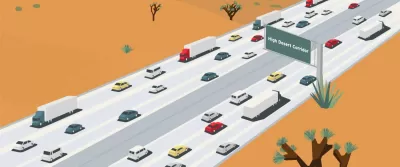What could have been the first new freeway for Los Angeles County in decades might now only mark the end of an era.

"A recent court settlement spells the end for the planned High Desert Corridor Freeway," reports Joe Linton from Southern California.
The High Desert Corridor would have been an $8 billion, 63-mile freeway spanning two counties—Los Angeles and San Bernardino. "In 2016, Caltrans certified the project’s Environmental Impact Report (EIR). The plan was for a High Desert 'multi-purpose corridor' featuring an 8-10 lane freeway, plus bike path, solar panels, and high-speed rail," according to Linton. The project was also lined up for nearly $2 billion in funding from Measure M, the L.A. County transportation sales tax approved by voters in 2016.
As explained by Linton, the project's EIR provoked a lawsuit from environmental groups, challenging the project on terms set by both state and federal environmental regulations. A judge sided with the plaintiffs, finding that the EIR was insufficient in measuring biological and greenhouse gas impacts. Instead of drafting a supplemental EIR, Caltrans has decided to shelve the project, reports Linton.
Frontier Group and U.S. PIRG earlier this year named the project as one of the nation's worst highway boondoggles, and now that the project is dead, the Los Angeles Times Editorial Board has taken a firm stance in opposition to the idea. The editorial raises one salient question that continues to plague land use and transportation planners in the state of California: Why is a state committed to reducing emissions and continuing to allow so much development in far-flung, exurban communities? The Trump administration has even begun to exploit the state's hypocrisy.
FULL STORY: Caltrans Settles Environment Lawsuit, Cancels High Desert Freeway Project

Alabama: Trump Terminates Settlements for Black Communities Harmed By Raw Sewage
Trump deemed the landmark civil rights agreement “illegal DEI and environmental justice policy.”

Planetizen Federal Action Tracker
A weekly monitor of how Trump’s orders and actions are impacting planners and planning in America.

The 120 Year Old Tiny Home Villages That Sheltered San Francisco’s Earthquake Refugees
More than a century ago, San Francisco mobilized to house thousands of residents displaced by the 1906 earthquake. Could their strategy offer a model for the present?

In Both Crashes and Crime, Public Transportation is Far Safer than Driving
Contrary to popular assumptions, public transportation has far lower crash and crime rates than automobile travel. For safer communities, improve and encourage transit travel.

Report: Zoning Reforms Should Complement Nashville’s Ambitious Transit Plan
Without reform, restrictive zoning codes will limit the impact of the city’s planned transit expansion and could exclude some of the residents who depend on transit the most.

Judge Orders Release of Frozen IRA, IIJA Funding
The decision is a victory for environmental groups who charged that freezing funds for critical infrastructure and disaster response programs caused “real and irreparable harm” to communities.
Urban Design for Planners 1: Software Tools
This six-course series explores essential urban design concepts using open source software and equips planners with the tools they need to participate fully in the urban design process.
Planning for Universal Design
Learn the tools for implementing Universal Design in planning regulations.
Clanton & Associates, Inc.
Jessamine County Fiscal Court
Institute for Housing and Urban Development Studies (IHS)
City of Grandview
Harvard GSD Executive Education
Toledo-Lucas County Plan Commissions
Salt Lake City
NYU Wagner Graduate School of Public Service





























